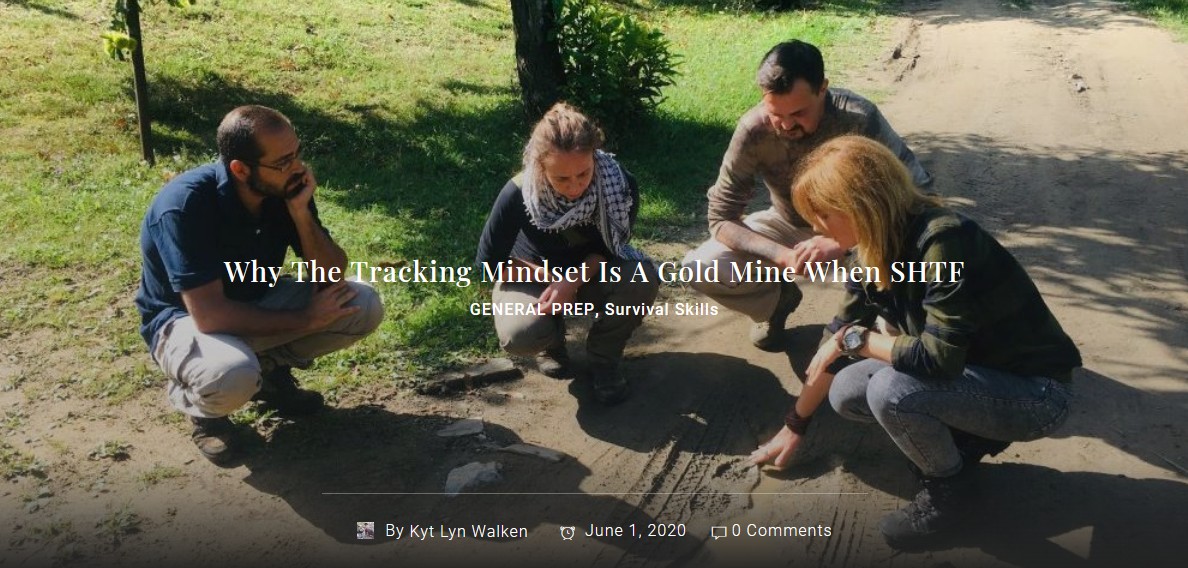
Survival Education from the Field of Master Mind Survival (MMSUR)
Shared from the research of: Joseph Mercado
Article Author: Kyt Lyn Walken – Survivopedia
To: Article Lover
Blog Post #959
Re: Developing a Tracking Mindset
Date and Time: Tuesday, June 2, 2020 at 5:48 p.m.
Dear Article Lover,
When the news started to rush about the seriousness of COVID-19 I found myself in a crowded Railway Station, the major in Rome (Italy), waiting to pick up my train back home from a two Tracking classes weekend…
I can clearly recall I was wearing an olive green colored shemagh, and seeing all the people wrapped into their scarves – the luckiest among them got the chance to purchase a mask – quite pushed me in emulating them.
The temperature outside was pretty much hot and the air seemed to give advance notice of Spring. It was Sunday, the 23rd of February.
I can label it as “the beginning of the worst“
Having the perception of being somehow in danger is, no doubts, a level that not exactly everyone does reach.
It depends on a lot of factors: knowledge, acquired preparedness, achieved successes in managing drastic situations.
In any case recorded, every scenario has proven to be marked by its own traits and “rules of engagement”.
Tough weather conditions, lack of proper gear, being into the void in terms of cardinal points or unavailability of connection for mobile phones (or GPS): if we add to that a skimpy preparedness we can easily lose any hope to get out safe and sound.
I am pretty sure that all the readers here have not only the required skills to face quite any hardship and mishap, but the most important thing, they can count on an ideal mindset to do that.
As I often tell my Students during Tracking Classes, especially at Basic Level, the starting point is ATTITUDE, which is firmly connected to MINDSET. The vanishing point is to give away and lose even the faith in.
There are no skills in which you can’t apply this specific point of view, which could literally save your life.
The Art of Tracking makes no Difference in that:
Our choices are always driven by the matching of attitude and mindset and, by that, we are able to gain benefits from them if applied in the right moment and in the appropriate dimension.
Personally speaking, I have been an outdoor enthusiast all my life, but the hunger for learning how to face an ongoing bad situation (and, consequently, how to fix it) came only with my mature age: in fact, I realized that accidents in life can easily happen anywhere, anytime.
My approach to the Art of Tracking just cruised the same path, as I turned to be into an individual who deeply matured in her heart and mind the willing to learn how to read and follow tracks.
Necessity plus curiosity can generate the right circumstances to survive.
The critical question is: why should a person start to track, notably in an emergency situation?
That is the top notch of the essential importance of the topic of this article.
The answer is far from being unpredictable: the ground (and, sequentially, the surroundings you are in) provides us all the data we may need to get out successfully.
Search and Rescue Teams are aware of this, especially if they can trust trained Trackers.
Trackers are surely not special breed people: they are trained to rely on mere facts and logic.
They accomplish their task just by reading carefully and analytically the ground; they interpret what they observe and consequentially follow the tracks of their interest.
They gather clues and put all the pieces together like in a puzzle. In this manner, they can understand how many persons passed on a specific trail, at what time, if they were carrying loads, and so on.
Again, Trackers are able to tell you if they were women and/or men if any animal passed before or after them if anything relevant happened. An unbelievable amount of information, if you think.
Various cases and crime scenes – murders, mass killings, and so on – have been solved by the legit application of the Art of Tracking.
Yosemite Muders and Oklahoma City Bombing, both occurred in 1995, just to mention you a couple.
Any disappearance in the woods can be handled through the utilization of the Art of Tracking, which happens to be extremely effective even if she comes straight from the Primitive Era.
Technological developments, in fact, seem to have not caused particular effects in successfully replacing the feasibility of this skill.
Equally speaking, learning this skill can come in handy if you find yourself lost, especially if you have no GPS and the connection is totally off.
Being stranded can surely offer you a good manner to try out your Survival and even Bushcraft abilities, but we can’t overlook that our very first instinct will remain to move along before the darkness come, and quickly searching for help.
Reading the tracks of other people on the ground, for example, can lead you to a safe place.
No doubt you need to be almost very good in that, principally if the soil is clearly tough to read to the presence of rocks, gravel, leaves, grass, and so on.
Think about a pine trees bed, for example: detecting clear footprints there can be extremely challenging.
Sandy and muddy soils are certainly precious aids in locating the trail to follow: on them, in fact, we can clearly see the outline of footprints.
On the other side, if you are an experienced Tracker, backtracking yourself will be probably your very first choice.
You may be familiar with your stride (the total length of your pace, measured from the heel of left footprint to the heel of right, or from toe to toe) and you are able to recognize the pattern (the design) of your boots.
Even in a situation of a pandemic like the current we are all living, this Art can mark the difference in selecting a safe place where to cross, for example: reading the ground, in fact, can allow you to understand how old is tracking, and, by that, avoiding the fresh ones, which can still bring the contamination of the virus.
Let me very specific on this point: in order to reach the lowest level of being a proficient Tracker, you should have gained experiences in years and years of “dirt time on ground” (as defined by Tracking’s terminology).
Every skill that can save your life requires that, and the ancient (and still so valuable!) art of reading, interpreting, and following Tracks makes no exception.
About the Author:
Kyt Lyn Walken is the official European representative and instructor for Hull’s Tracking School (Virginia, USA), and she is a certified Conservation Ranger for C.R.O.W. (Conservation Rangers Operations Worldwide). She has been an outdoors and tracking enthusiast since childhood. She is free lance writer for several magazines based in US and UK. Kyt lives and works in Europe even if she often travels overseas, and can be contacted at www.man-tracking.com.
Content Source: Survivopedia.com

 Email Us a Message
Email Us a Message 

Please send us a personal message below and we will serve you momentarily.



 Fly Over to the MMU Facebook Page with Hoot
Fly Over to the MMU Facebook Page with Hoot 

 Join the MMU Facebook Group Today
Join the MMU Facebook Group Today 